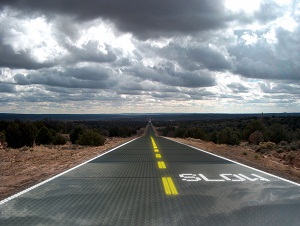Solar Roadways leading in GE funding challenge
 Scott Brusaw loved to play with electric slot cars when he was a young boy growing up in Orange County, Calif.
Scott Brusaw loved to play with electric slot cars when he was a young boy growing up in Orange County, Calif.
“Why don’t we make real roads electric,” he thought even then. “Then even little kids could drive and my parents wouldn’t have to worry about it.”
That idea has stayed with him ever since.
Scott grew up to marry Julie, whom he went to daycare with at the young age when he was first introduced to the idea of electric roads. Now the two own a company based in Sandpoint, Idaho, called Solar Roadways. They believe we can get rid of petroleum-based asphalt and pave roadways with photovoltaic panels, structurally reinforced the way the indestructible black box in an airplane is.
Their company is vying for up to $200 million in funding from GE’s Ecomagination Challenge, which wraps up Thursday.
The public is able to vote on revolutionary ideas to create power, connect power, and use power. The Brusaws’ idea for solar roadways is in the top five in all three categories.
Among the competing ideas are Herbert Samuel’s Welectricity, which is a social networking site that allows homeowners to create a household utility profile and share cost- and energy-saving tips online. Another is Clarian’s Plug and Play solar panels that allow the average person, whether he owns or rents, to install an energy-saving solar panel and plug it in to any electrical outlet at the home. Yet another GE Ecomagination contender is a company that wants to create battery-swapping stations for electric cars so drivers won’t have to wait to charge their vehicles.
While the public gets to vote on viable technologies, it really only helps to draw attention to them. GE judges get the final say in what the company will fund.
Solar Roadways won $100,000 in funding from the Federal Highway Administration last year to create a prototype. The trick has been engineering the glass cover for the panels, Scott said.
The glass needs to be strong enough to support cars and endure collisions, but translucent enough to allow the sunlight to reach the panels. It needs to allow enough traction to remain safe even in inclement weather.
The Brusaws have made significant advances with the technology and have highly qualified engineers and glass experts on the job.
All the other cool things a solar roadway might be able to do, like melting the snow off its surface, sensing a child or a deer in the path ahead and flashing warnings, are an amalgamation of already-existing technologies.
“To melt the snow, we thought of the rear window in your car,” Scott said. “We’re really just bringing a whole bunch of old technologies together. Even the solar panels. Carter had [solar] panels on the White House in the ‘70s. That technology has been around forever. The only thing new is the glass.”
With two days left before GE Ecomagination closes voting on its Challenge, Scott says he’s glad to have their attention. To make this dream a reality, which he firmly believes can be done, Solar Roadways needs funding.
“We’re hoping to get a partnership out of this,” Scott said.
To vote, visit Solar Roadway's site.
Pictured: Artist Dan Walden's mock-up of the Brusaws' solar roadway.



